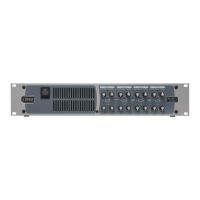
Do you have a question about the Cloud 46 Series and is the answer not in the manual?
| Channels | 2 |
|---|---|
| Signal-to-Noise Ratio | >100dB |
| Input Impedance | 20k Ohms |
| Dimensions | 19" |
| Weight | 3.5kg |
Introduces the Cloud 46 Series four-zone mixer-amplifiers and the Installation and User Guide.
Explains critical safety symbols like 'Caution' and 'Warning' and their meanings.
Provides a numbered list of essential instructions for safe operation, handling, and maintenance.
Details precautions for installing the unit safely, including ventilation and environmental factors.
Covers product conformity, hazardous substance declarations, and specific electrical safety points.
Introduces the mixer-amplifiers, lists applicable models, and highlights key features.
Lists the items provided in the product packaging for the 46 Series mixer-amplifiers.
Illustrates the internal signal flow and connections within the mixer-amplifier.
Details the controls, indicators, and their functions on the front panel of the unit.
Details the various input/output connectors and controls located on the rear panel.
Explains DIP switch settings for remote control ports and speaker output configurations.
Covers rack mounting, ventilation requirements, and operating temperature ranges.
Details the unit's power supply type, fuse ratings, and replacement procedures.
Describes music inputs, gain controls, source selection, and music level adjustments.
Explains how to connect and use remote control plates for music source and level.
Details music EQ adjustments and the music priority function for audio sources.
Covers microphone inputs, connections, gain, level controls, and equalization.
Explains how to configure paging operation and mic-over-music priority using DIP switches.
Details connecting PM Series paging microphones using the Cloud Digital Paging Interface.
Describes connecting paging microphones using the analogue interface and MIC 1 ACCESS CONTACTS.
Details speaker output options for low-impedance and 70/100 V-line systems.
Provides connection guidance for Lo-Z and 70/100 V-line loudspeaker systems.
Explains the power sharing feature available on the 46-120MK2 model for Hi-Z operation.
Describes how to configure parallel operation for increased power output in a single zone.
Details auxiliary outputs for expansion and the utility output for secondary audio feeds.
Details the purpose of facility ports and how to configure audio routing using jumpers.
Explains how to use facility ports for remote control of music source and level.
Provides instructions for connecting LM-2, BT-1, L-1, and M-1 modules to facility ports.
Describes the music mute input for fire alarm integration and the energy-saving Auto Power Down feature.
Details how to control music source and level using external DC voltages via control ports.
Describes Ethernet and RS-232 interfaces for remote control of the mixer-amplifier.
Lists common ASCII and HEX commands for controlling the unit remotely.
Provides examples for music source selection, level adjustment, and mic muting commands.
Diagram showing the locations of internal PCB jumpers and their general purpose.
Details the function, location, and factory default setting for each internal jumper.
Helps diagnose and resolve fault conditions indicated by status LEDs and operational issues.
Discusses electromagnetic compatibility and earthing practices for optimal performance.
Lists detailed electrical and performance specifications for line, microphone, and facility inputs.
Details output power ratings, load impedances, protection features, and general unit characteristics.
